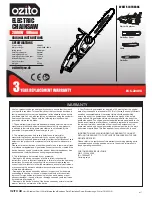
8. CUTTING APPLICATIONS
MAINTENANCE
APPLICATIONS
Bucking is cutting a log into lengths for
easier handling. To saw a log lying on the
ground, first saw halfway, then roll the log
over and cut from the opposite side.
To saw the end of a log supported off the
ground, first saw up from the bottom one-
third through the log then finish by sawing
down from the top. To saw a log in the
middle of two supports holding it off the ground, first saw down from the
top one-third through the log then finish by sawing up from the bottom.
Limbing is the process of removing the
branches from a fallen tree. Check the
direction in which a branch will bend
before cutting it. Always cut on the
opposite side to the bending direction
so that the guide bar is not pinched in
the cut. For large limbs that cannot be
removed in one cut, make an initial cut from the bent side and finish
by sawing from the opposite direction. Do not remove limbs that are
supporting the fallen tree on the ground until the tree has been cut into
lengths.
Pruning is the removal of a limb or branch
from a standing tree.
Felling a tree
Decide the direction in which you wish
the tree to fall, taking into account the
direction of the wind, the position of
branches, lean of the tree, ease of
subsequent limbing and bucking and
other factors prevalent at the time.
1
2
Limbing
1
2
1
2
Bucking
CAUTION!
AVOID CUTTING INTO THE GROUND AS THIS
WILL VERY QUICKLY DULL THE CHAIN.
Pruning
1
2
Chain Sharpening
Chain File
: 3.96mm (5/32”)
Chain Pitch
: 9.53mm (3/8”)
Chain Gauge
: 1.3mm (0.050”)
Sharpen the chain regularly to maintain
optimum performance of the saw. Signs of a
dull chain are:
• The sawdust becomes powder-like
• Extra force is required to execute a cut
• The cut does not track in a straight line
• Increased vibration
Sharpen each cutter using a chain file. Always use outward strokes and
maintain a 30° angle between the chain and file. After sharpening, the cutters
must all have the same width and length.
After every 3 – 4 uses get an authorised repair centre to professionally
sharpen your chain. They have the special tools necessary to ensure the
correct cutting angles and depths.
Chain tension
Check the chain tension frequently and adjust as often as necessary. (see
Tensioning the chain
)
Maintaining the guide bar
1. Remove any sawdust from the guide bar, including the groove.
Oil and sawdust combine and emit a burning smell during operation if the
blade is not regularly cleaned.
2. Make sure that the oil port is not clogged. Grease
the nose sprocket at the tip of the guide bar.
3. Check for oil leakage and loose fastenings,
especially those securing the handles and the
guide bar.
4. Clean any dust away from the cooling vents as
clogged vents can cause overheating. By maintaining a clean unit you will
extend the useful life of the chain and the tool in general.
WARNING!
FELLING A TREE SHOULD ONLY BE
DONE BY TRAINED OPERATORS.
WARNING!
ALWAYS KEEP A BALANCED STANCE.
DO NOT STAND ON THE LOG. BE ALERT TO
THE FACT THAT THE LOG MAY ROLL OVER. WHEN
WORKING ON A SLOPE, ALWAYS STAND ON THE UP
HILL SIDE OF THE LOG.
WARNING!
DO NOT USE AN UNSTABLE FOOT-
HOLD OR LADDER. DO NOT OVERREACH. DO
NOT SAW ABOVE SHOULDER HEIGHT. ALWAYS USE
BOTH HANDS TO HOLD THE SAW. FIRST CUT UP FROM
THE BOTTOM AND FINISH DOWN FROM THE TOP.
WARNING!
ENSURE THE CHAINSAW IS TURNED
OFF & DISCONNECTED FROM THE POWER SUPPLY
BEFORE PERFORMING ANY OF THE FOLLOWING
OPERATIONS.
outward
stroke
30
WARNING!
WEAR HEAVY GLOVES WHEN HANDLING
THE CHAIN. HOLD THE GUIDE BAR SECURELY IN A
VICE.
Cleaning and storing
• Keep the handles free of grease so that you can maintain a firm grip.
• Clean the device as required with a damp cloth and, if necessary, mild
washing up liquid.
• If the chainsaw is not to be used for an extended period of time
then you should remove the chain oil from the tank. Briefly immerse the
chain and the cutter rail in an oil bath and then wrap them
in oil paper.
CAUTION!
ALWAYS DISCONNECT THE MAINS PLUG BEFORE
CLEANING THE CHAINSAW.
CAUTION!
NEVER IMMERSE THE UNIT IN WATER OR OTHER
LIQUIDS IN ORDER TO CLEAN IT.
CAUTION!
STORE THE CHAINSAW IN A SAFE AND DRY
PLACE OUT OF THE REACH OF CHILDREN.


























